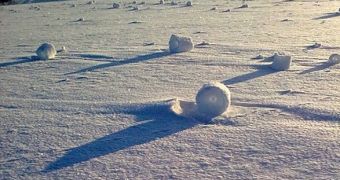When they were first discovered, snow rolls, or snow pipes as they are also called, were thought to be the work of aliens, pranksters or some undiscovered species of animals building a nest. But subsequent studies of the peculiar structures have revealed that they are all-natural, and also that they most often appear on open grounds subjected to subzero temperatures, such as the prairies of North America. Researchers have since determined that the rolls are the wintry equivalent of tumbleweed.
According to the Daily Mail, the structures require very precise conditions to form. Among the factors that contribute to their formation, experts include the air temperature, ice, snow, moisture and wind. A recent sighting took place in Yeovil, Somerset, as two people who were walking their dog got a chance to see the snow rolls on an open field.
“We saw them from a distance on the ridge of the field, and we thought some kids had been playing up there and making giant snowballs. But when we got up there we saw there were no footprints and there were hundreds of them, too many for children to have done it. We realized it must have been the wind,” Ron Trevett, who was walking the dogs with his wife, Aileen, said.
“They start off with a nice thick layer of snow, with the top snow just on the point of melting either because of general temperature or sunshine on the surface. The top snow layer becomes a bit sticky and you then need a fairly strong wind. The sticky layer can be peeled off the colder and more powdery snow underneath by the wind, forming a roll. In the first picture you can see some of the powdery stuff sticking to the lower outside surface of the roll. I suppose it is a natural version of making a snowman,” Met Office lecturer in meteorology Frank Barrow explained the formation process.
Sightings of snow rolls are fairly rare in the United Kingdom, where these ones were found. This is because the country is fairly unlikely to experience the major snow events it does now. The whole of Europe has been affected by a large wave of snow just before New Year's, and most likely this contributed to the unusual snow pipes. “There are quite strong winds predicted this weekend as well as more snow, so if people keep a look out they might see a few more of these appearing around the country over the next few days,” Royal Meteorological Society expert Liz Bentley concluded.

 14 DAY TRIAL //
14 DAY TRIAL //